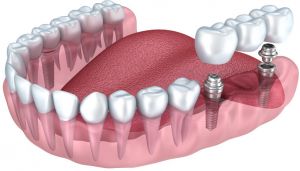
In an ideal world, your natural teeth would remain strong and healthy, and last throughout your entire life. In the real world, illness, trauma, and dental disease can result in weakened, damaged, or missing teeth. Bridges and crowns are dental prosthetics that can be used to improve the appearance of your smile and quality of your life by replacing missing teeth or strengthen existing ones. Although some patients need both crowns and bridges, other patients require only one of these dental appliances.
All About Crowns
Crowns are used to improve the appearance of chipped, discolored, or crooked teeth. They are often used after a root canal or recommended when a tooth has a large cavity and it’s difficult to successfully fill.
Crowns are artificial teeth that are cemented onto natural teeth or metal posts that have been affixed to the jawbone. If the crown will be visible, when you smile for example, Dr. Labib will make sure that it’s made out of porcelain or ceramic and in a shade that matches the surrounding teeth. For molars, we often order crowns made from gold or silver. However, we can also order metal crowns for front teeth and porcelain crowns for molars.
All About Fixed Bridges
Bridges are dental prosthetics used to fill a gap left by one or more missing teeth. We normally recommend bridges for patients who’ve lost at least two adjacent teeth, where as an individual tooth is often successfully replaced with an implant.
Fixed bridges are permanently cemented in place, so only a dentist can remove them. There are three common types of fixed bridges available: traditional bridges; resin-bonded bridges; and cantilever bridges.
- Traditional bridges are anchored to the two teeth adjacent to the gap. If the adjacent teeth are strong and healthy, Dr. Labib may crown them to improve their stability. If the adjacent teeth are broken or diseased, he may use implants to anchor the bridge.
- Resin-bonded bridges consist of a metal framework on which artificial gums and teeth are constructed. This type of bridge features metal wings that are bonded to the two adjacent teeth.
- We sometimes use a cantilever bridge to replace a single tooth. This type of bridge is normally used when there is no adjacent tooth on one side of the gap. They are not recommended if the bridge is going to be subjected to great stress.
All About Removable Bridges
Removable bridges are more correctly called removable partial dentures. Like fixed bridges, they are used to span gaps resulting from lost teeth. Removable bridges are usually held in place by clasps that attach to adjacent teeth, but they may also be supported by metal posts or implants. Removable bridges can be removed by the wearer for easy cleaning and better oral hygiene.
Procedure for Bridges and Crowns
The exact procedure that Dr. Labib will follow depends on your specific situation. However, before he can have a bridge or crown made, the existing teeth must first be contoured so that the prosthetic will fit properly. For many patients, this merely requires removing a tiny bit of the enamel. In some cases, Dr. Labib may need to alter the shape or profile of the teeth that will be affected. If you need implants, support posts will be affixed.
The next step is to make a mold that will produce your crown or bridge. This dental impression is sent to the lab to make your prosthetic. We place a temporary bridge or crown over the prepared tooth that should last until your permanent one is ready. Once we receive the bridge or crown from the dental lab, we will schedule an appointment to have your temporaries removed and the crown or bridge cemented in its place.
Life Expectancy of Crowns and Bridges
The crowns or bridges may last for the rest of your life, but they may become loose on occasion. They can also be damaged if you chew ice or other hard foods, but not to worry: regular checkups, good dental hygiene, and professional cleanings can help you maintain your bridges and crowns for many years to come.